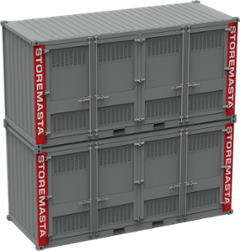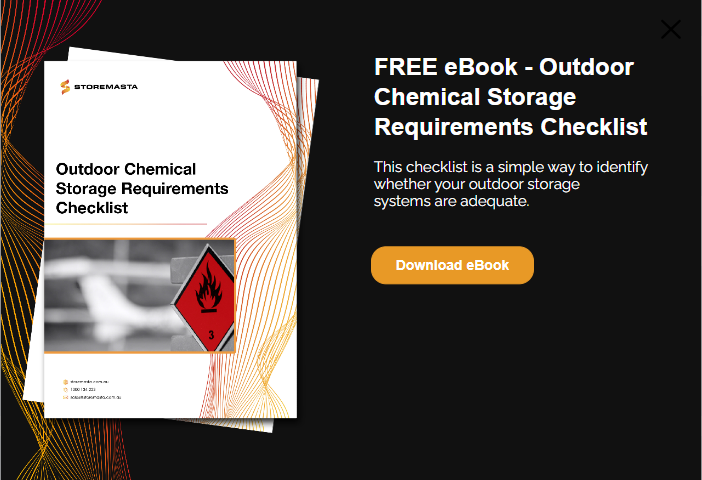Are you thinking about storing dangerous goods outdoors? Before you set up your chemical store, there are a few key factors that you need to consider. The outdoor environment poses a range of risks that indoor operations simply don’t. Making sure your storage situation is compliant is vital for the health and safety of your site. In this post, we’ll detail some key issues that may arise in the outdoor environment — and suggest ways that you can reduce chemical risk through engineering controls.
Extreme Temperatures
Not all chemicals can be kept in an outdoor environment, with extreme cold and heat having the potential to affect the safety, stability and functionality of some substances.
The first step in determining your outdoor chemical storage requirements, is to check the suitability of your chemicals for storage outdoors. To determine if your chemicals require storage at a specific temperature range, check the product’s Safety Data Sheet (SDS).
In Section 7 handling and storage, you will find any direction relating to the storage of your chemical product. If chemicals require specific storage conditions, such as ample ventilation, not being stored in direct sunlight, or being kept at specific temperatures, the information will appear in this section of the SDS.
If the conditions at your site are too extreme for outdoor storage, consider installing a parasol roof over your container to block direct sunlight. Alternatively, you may wish to invest in temperature-controlled storage that offers a range of controls to regulate ambient temperatures.

Check Section 7 in your SDS to see if your product is suitable for storage in the outdoor environment.
Separation Distances
Did you know that outdoor chemical stores may be subject to specific separation requirements from protected and public places?
The distances from which chemical stores can be located from protected and public places, is detailed in the relevant Australian Standard.
Protected places can be sites such as schools, colleges, hospitals, places of worship, public buildings and residential premises. The definition of protected places also includes open areas where people may congregate.

Check the separation distances to ensure your store is located away from public and protected places, such as educational facilities, hospitals and residences.
Public places, on the other hand, are spaces that the public are freely able to use. This may include parks, community facilities and walkways.
To determine the location of your outdoor store, refer to the relevant Standard. You must also consider if you have adequate space to allow for outdoor storage under these separation guidelines.
The separation distances are in place to protect people, the community and the surrounding environment from the risks that are associated with the storage of hazardous chemicals.
Environmental Conditions
If you’re storing your chemicals indoor, within a compliant safety cabinet, there is very little risk that your cabinet could be accidentally knocked over or damaged during normal daily duties. However, when you’re storing your chemicals outdoors, you are subject to environmental conditions.
Extreme weather, such as lightning storms, severe winds and cyclonic conditions can greatly affect the safety and stability of stored chemicals. Add to this the additional risk of bushfires and floods, and you could be facing a situation that can destabilise and damage your outdoor chemical store.
To reduce the risk of ignition near your outdoor chemical stores, we strongly recommend keeping all vegetation at a minimum. Trees, bushes and long grass should be kept manicured, with any undergrowth cleaned away. Make sure that there are no overhanging trees or branches, as these may come into contact with your store in the event of strong winds.
A primary query when considering outdoor chemical storage options is to consider how strong, durable and stable the store will be? Is the store constructed from corrosion-resistant materials? Can it be anchored down? Is the construction strong enough to withstand cyclonic conditions? These are just some of the questions that you’ll have to ask when determining your storage requirements.
Is your outdoor chemical store suitable for harsh Australian conditions?
Consider the following features for protection against environmental elements:
- All steel construction (for corrosive substances, PVC spill trays for smaller units, and polyethylene liners in sump for larger units, will be required)
- No rubber seals (for a waterproof design — generally featured in DG containers only)
- Cambered roof (to assist with rain run-off and protection against corrosion)
- Cyclone-proof construction (check the rating to see if it’s applicable for your site)
Impact Damage
Following on from the concerns about the stability and safety of your outdoor store, another key consideration is the potential for impact damage.
While you can isolate potential hazards by placing your store in a clear, uninhibited spot – away from overhanging trees and out of the way of vehicle traffic – protecting your store from impact damage can be achieved through engineering controls.
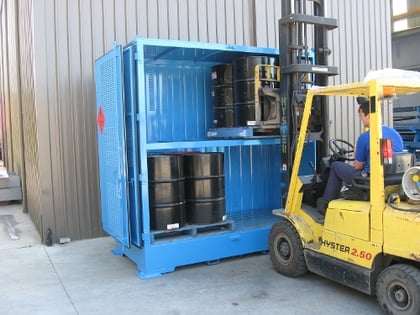
Chemical containers must not suffer from impact damage, such as a hit from a forklift, as it can cause stored packages to fall and spill.
Outdoor chemical stores can come in a range of shapes and forms: from fenced, secure outdoor areas to roofed structures attached to buildings.
However, the best protection against any type of impact damage – whether it’s vehicles, vandalism or environmental elements – is to store your hazardous chemicals in a chemical storage container (such as an IBC or drum store) or a relocatable DG container.
Security Issues
Many chemicals, such as Class 6 Toxic Substances, must be stored in a secure outdoor location to maintain compliance. This is due to the potential for harm if chemicals are stolen, misused or vandalised.
Indoor storage cabinets don’t require the same security measures as outdoor chemical stores. This is because most premises already have a complex security system, including locked doors, CCTV and employee verification systems.
In the outdoor environment, there is an increased risk that chemicals may be tampered with or stolen due to the lack of security measures.
ISO locking bars on chemical containers offers the highest level of protection, with the secure system effectively preventing unathorised entry. You can also implement additional security measures for your site, such as barb wire fencing, security camera surveillance and restricted entry to the outdoor area for unathorised staff.
If you check the Australian Standard for the chemical class that you’re carrying, you will find the requirements that relate to security of your store in the outdoor environment. It’s important to adhere to the set requirements, as this will ensure that you meet your compliance obligations and offer the safest outdoor storage for your hazardous substances.
Lightning Protection
The chances of your indoor store being affected by lightning is unlikely, but in the outdoors – a lightning strike can cause horrific incidences of fire, explosion and dangerous chemical reactions.
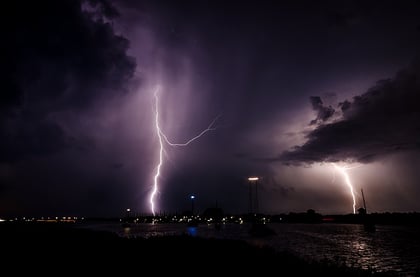
If lightning strikes a non-compliant flammable store, chemicals can quickly ignite and cause a destructive blaze.
When installing an outdoor chemical store, consider the measures you’ll need to take to minimise the likelihood and impact of lightning.
The Australian Standard for Class 3 Flammable Liquids, AS 1940:2017, explains that outdoor stores require compliant lightning protection (AS/NZ 1768) and earthing (AS/NZ 1020). Earthing the container is the process of installing an earth rod, so that any currents are discharged into the earth.
By equipping your store with lightning protection and an earth rod, you will minimise the impact of electrical currents, such as a bolt of lightning, from igniting the flammable chemicals that you’re storing outside.
Spillage
When working in the outdoor environment, there are a range of extra risks associated with the use and transferal of hazardous substances. From chemical deliveries to decanting and pumping, it’s common that dangerous goods may leak or spill during handling and storage processes.
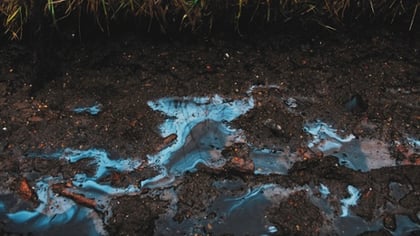
When handling or storing dangerous goods outdoors, be careful to protect the natural environment from any type of contamination.
While bunded storage and spill containment systems are a requirement under WHS Regulations, it’s imperative that your handling and storage practices reduce the risk of environmental damage and pollution. Unlike indoor situations, chemicals can quickly penetrate soil, spill into waterways or travel into ecosystems affecting the health of fauna, as well as farm animals.
To reduce the impact of outdoor chemical spills, why not implement the following measures:
- Have dedicated decanting and pumping stations away from drains, bare earth and waterways
- Use handling equipment when moving chemicals around the site
- Organise chemical deliveries so that they’re taken directly to the appropriate outdoor chemical storage facility
- Never handle, store or transfer chemicals on ground that doesn’t have sealed concrete or another impervious surface
- Ensure that there are no open drains near handling or storage areas. If there are drains in those areas, use floor bunding to prohibit spillage from entering drains
- Always have the appropriate spill kits in any area that uses, handles, generates or stores hazardous chemicals
Storing Dangerous Goods Safely In The Outdoor Environment
Would you like to learn more about the safe storage of dangerous goods outdoors? While there are multiple factors to consider, our handy checklist can simplify the matter of outdoor chemical storage.
Our Outdoor Storage Requirements Checklist features all the necessary considerations and will quickly help you determine your storage requirements. Grab a copy of our checklist today by simply clicking on the image below.
Joining the team as a Dangerous Goods Storage Consultant, Melissa Hampton became Storemasta's Marketing Manager in late 2021. With extensive knowledge and experience in chemical compliance, Melissa is responsible for leading the Marketing team and helping shape their marketing strategy. In her spare time, you can find Melissa hiking, swimming and enjoying the great outdoors in beautiful north-west Tasmania.
